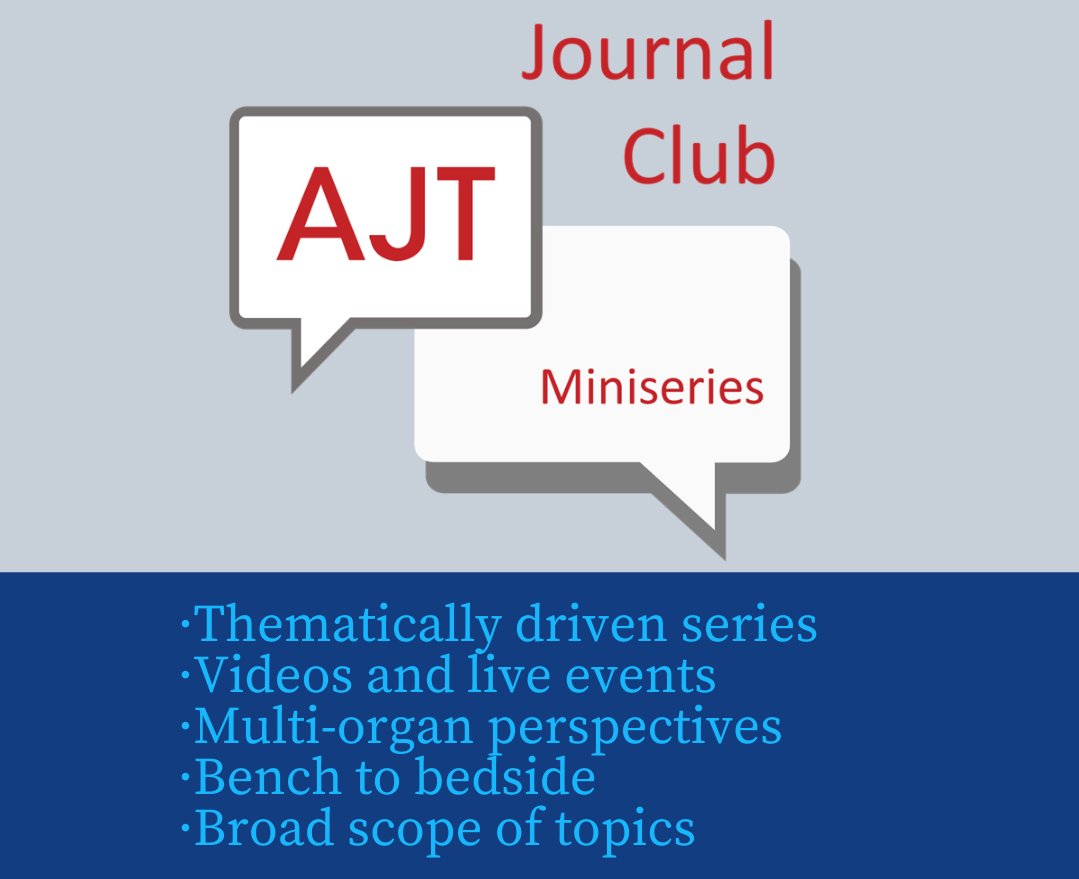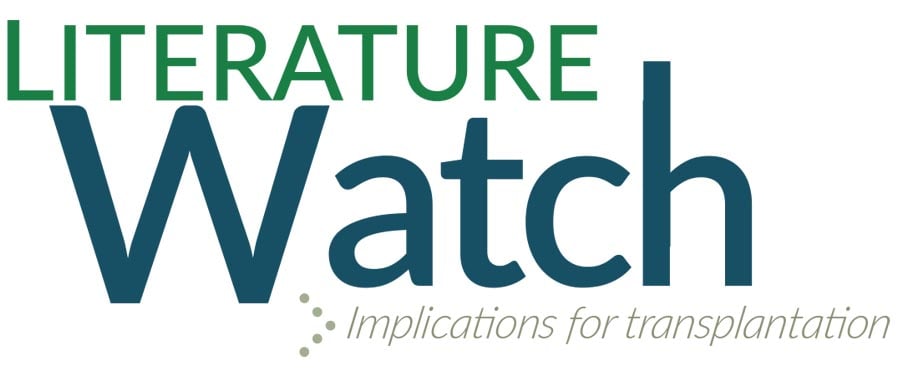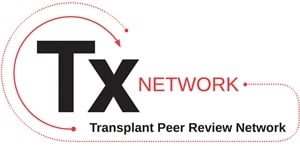Journal list menu
Export Citations
Download PDFs
The AJT Report
The AJT Report News and issues that affect organ and tissue transplantation
- Pages: 1999-2000
- First Published: 29 September 2011
Do accountable care organizations make sense for transplantation? This month, “The AJT Report” investigates how this element of healthcare reform may impact transplant patient care and clinical practice. Also this month, we look at new legislation that hopes to expand immunosuppressant drug coverage, and report on findings of a new study focused on risk factors for pediatric heart disease.
Literature Watch
LITERATURE Watch Implications for transplantation
- Page: 2001
- First Published: 29 September 2011
There are likely hundreds of undefined species of bacteria and viruses that contribute to diverse maladies in transplant patients. “Literature Watch” highlights several reports investigating associations between pathogens and specific syndromes that have generated much debate and provided several important implications for clinicians.
Editorials
New Partners for Tolerogenic Dendritic Cells
- Pages: 2003-2004
- First Published: 09 August 2011
The authors provide perspective on the findings of Hill and colleagues that show a novel means by which autologous dendritic cells might facilitate allograft tolerance. See article on page 2036.
Reverse Chimerism: Stem Cells Going the Other Way
- Pages: 2005-2006
- First Published: 30 August 2011
Mobilized host stem cells populate donor liver allografts, establishing reverse chimerism and tolerance in a highly allogenic rat liver transplantation model. See article by Okabayashi et al on page 2046.
Accommodation: How You See It, How You Don’t
- Pages: 2007-2008
- First Published: 09 August 2011
Commenting on achieving accommodation in presensitized nonhuman primates, the author discusses how complement might contribute to accommodation and why accommodation might fail to be identified. See article by Chen et al on page 2057.
Significant Potential Utility for Donor Yield Models: But Proceed With Caution
- Pages: 2009-2011
- First Published: 03 August 2011
While donor yield models should be viewed as valuable tools for the transplant community, their application for regulatory and quality oversight should be carefully considered given potential for unintended consequences and systematic biases between organ procurement organizations. See article by Messersmith et al on page 2075.
Minireview
The Emerging Role of the TIM Molecules in Transplantation
- Pages: 2012-2019
- First Published: 11 September 2011
This review highlights the emerging data regarding the T cell immunoglobulin mucin domain family of molecules and their potential in transplantation tolerance.
Special Article
Influenza Vaccination in the Organ Transplant Recipient: Review and Summary Recommendations
- Pages: 2020-2030
- First Published: 29 September 2011
This article on influenza vaccination after organ transplantation discusses specific evidence-based recommendations for immunization including timing, vaccine type, and the effect of immunosuppressive medication on vaccine response rates. See accompanying general guidelines from the CDC on page 2250.
Personal Viewpoint
Liver Transplantation for Hepatocellular Carcinoma: Five Steps to Prevent Recurrence
- Pages: 2031-2035
- First Published: 10 August 2011
The authors discuss established and potential ways of improving outcomes after liver transplantation for hepatocellular carcinoma, refining recipient selection, decreasing the release and the engraftment of circulating cancer cells, using anti-cancer drugs and tuning immunity towards cancer clearance.
Original Articles
Basic Science
Cell Therapy With Autologous Tolerogenic Dendritic Cells Induces Allograft Tolerance Through Interferon-Gamma and Epstein-Barr Virus-Induced Gene 3
- Pages: 2036-2045
- First Published: 27 July 2011
The authors describe how the injection of autologous tolerogenic dendritic cells triggers Interferon-gamma and Epstein-Barr virus-induced gene 3-dependent immunoregulatory mechanisms leading to allograft tolerance in a rat model. See editorial by Zhang and Thomson on page 2003.
Mobilization of Host Stem Cells Enables Long-Term Liver Transplant Acceptance in a Strongly Rejecting Rat Strain Combination
- Pages: 2046-2056
- First Published: 30 August 2011
Treatment with a brief course of low-dose tacrolimus combined with plerixafor to mobilize host stem cells results in graft repopulation and long-term acceptance without further treatment in a rat strain combination that otherwise rejects liver grafts acutely. See editorial by Kim and Zavazava on page 2005.
Complement Inhibition Enables Renal Allograft Accommodation and Long-Term Engraftment in Presensitized Nonhuman Primates
- Pages: 2057-2066
- First Published: 10 August 2011
Short-term inhibition of complement prevents the early antibody response induced against donor antigens and enables renal allograft accommodation and long-term engraftment in donor skin-presensitized cynomolgus monkeys. See editorial by Platt on page 2007.
Multiphoton Intravital Microscopy of the Transplanted Mouse Kidney
- Pages: 2067-2074
- First Published: 11 August 2011
This article reports the methodology to perform multiphoton intravital microscopy imaging of transplanted kidneys in mice and measures the early effects of the transplantation procedure on the graft.
Clinical Science
Development of Donor Yield Models
- Pages: 2075-2084
- First Published: 09 August 2011
This study shows the potential value of models predicting organ yield per donor as evaluation metrics and tools that can inform practices in donor management and organ utilization. See editorial by Goldfarb and Schold on page 2009.
Lifetime Probabilities of Needing an Organ Transplant Versus Donating an Organ After Death
- Pages: 2085-2092
- First Published: 03 August 2011
Based on an actuarial analysis of lifetime probabilities, the authors find that Canadians are 5 to 6 times more likely to need an organ transplant than to become a deceased organ donor, and depending on age, 30–40% of those in need of a transplant will never receive one.
Systematic Review: Kidney Transplantation Compared With Dialysis in Clinically Relevant Outcomes
- Pages: 2093-2109
- First Published: 30 August 2011
In a systematic review of kidney transplantation compared with dialysis, the authors find that the relative magnitude of the benefit due to transplantation appears to increase over time.
MicroRNA Profiles in Allograft Tissues and Paired Urines Associate With Chronic Allograft Dysfunction With IF/TA
- Pages: 2110-2122
- First Published: 27 July 2011
The authors identify a characteristic microRNA signature for chronic allograft dysfunction with interstitial fibrosis and tubular atrophy that correlates with paired urine samples from kidney transplant recipients.
Early Ultrastructural Changes in Renal Allografts: Correlation With Antibody-Mediated Rejection and Transplant Glomerulopathy
- Pages: 2123-2131
- First Published: 09 August 2011
Ultrastructural changes of glomerular endothelial injury are frequently seen in early renal allograft biopsies showing C4d-positive or C4d-negative antibody-mediated rejection, and treatment in this setting significantly reduces subsequent progression to overt transplant glomerulopathy.
Revisiting Traditional Risk Factors for Rejection and Graft Loss After Kidney Transplantation
- Pages: 2132-2143
- First Published: 03 August 2011
When stratifying kidney transplant recipients by sensitization history and day of transplant serum analysis, univariate and multivariate analysis reveals donor-specific sensitization to be the most important risk factor for rejection.
Autoantibodies Specific for the Phospholipase A2 Receptor in Recurrent and De Novo Membranous Nephropathy
- Pages: 2144-2152
- First Published: 09 August 2011
Autoantibodies specific for the phospholipase A2 receptor are present in 5 of 10 patients with recurrent membranous nephropathy, in none of 9 patients with de novo membranous nephropathy, and in 3 of 6 patients who have not recurred, which questions their predictive value.
Long-term Impact of Subclinical Inflammation Diagnosed by Protocol Biopsy One Year After Renal Transplantation
- Pages: 2153-2161
- First Published: 22 August 2011
Subclinical inflammation, as diagnosed by protocol biopsy at 1 year, in renal transplant patients switched from cyclosporin A to sirolimus at month 3, is significantly more frequent in the sirolimus arm and associated with subsequent lower renal function.
Intragraft Regulatory T Cells in Protocol Biopsies Retain Foxp3 Demethylation and Are Protective Biomarkers for Kidney Graft Outcome
- Pages: 2162-2172
- First Published: 12 July 2011
Bona fide Tregs in clinically stable acute cellular infiltrates in renal transplant recipients maintain Foxp3 demethylation at the TSDR level, and are associated with a favorable graft outcome.
Donor Kidney Adapts to Body Dimensions of Recipient: No Influence of Donor Gender on Renal Function After Transplantation
- Pages: 2173-2180
- First Published: 10 August 2011
The living donor kidney adapts to body dimensions of the recipient, irrespective of gender.
Association of Cytomegalovirus Infection and Disease With Death and Graft Loss After Liver Transplant in High-Risk Recipients
- Pages: 2181-2189
- First Published: 09 August 2011
The authors perform a restrospective analysis of 227 cytomegalovirus donor seropositive, recipient seronegative liver transplant recipients, and find an increased risk of death and graft loss associated with subsequent cytomegalovirus infection and disease within the first year after transplant.
Cytomegalovirus Replication Within the Lung Allograft Is Associated With Bronchiolitis Obliterans Syndrome
- Pages: 2190-2196
- First Published: 27 July 2011
Examining a cohort of lung transplant recipients receiving short-course cytomegalovirus prophylaxis, the authors find that 41% of recipients develop evidence of cytomegalovirus replication in the bronchoalveolar lavage fluid and that this is associated with an increased risk of bronchiolitis obliterans syndrome.
The Impact of Pretransplant Mechanical Ventilation on Short- and Long-Term Survival After Lung Transplantation
- Pages: 2197-2204
- First Published: 10 August 2011
The authors show that poorer posttransplant survival in lung transplant recipients who are mechanically ventilated at the time of organ matching is limited to the early posttransplant period and to certain listing diagnoses.
Brief Communications
Therapy With m-TOR Inhibitors Decreases the Response to the Pandemic Influenza A H1N1 Vaccine in Solid Organ Transplant Recipients
- Pages: 2205-2213
- First Published: 10 August 2011
This study assesses the immunogenicity, efficacy and safety of the pandemic H1N1 vaccine in solid organ transplant recipients, and shows that although the pandemic vaccine elicits an adequate response, patients receiving mTOR inhibitors achieve lower seroprotection rates.
The Prognostic Value of Renal Resistance During Hypothermic Machine Perfusion of Deceased Donor Kidneys
- Pages: 2214-2220
- First Published: 11 August 2011
Increased renal resistance during hypothermic machine perfusion of deceased donor kidneys associates with the development of delayed graft function and 1-year graft survival, but cannot be used exclusively in the process of accepting a kidney graft.
Urinary miR-210 as a Mediator of Acute T-Cell Mediated Rejection in Renal Allograft Recipients
- Pages: 2221-2227
- First Published: 03 August 2011
The authors find that low levels of miR-210 in urine identifies patients with acute T-cell mediated rejection and predicts long-term kidney function, thus serving as a novel biomarker of acute kidney rejection.
Urinary Chemokines CXCL9 and CXCL10 Are Noninvasive Markers of Renal Allograft Rejection and BK Viral Infection
- Pages: 2228-2234
- First Published: 03 August 2011
Urinary chemokines CXCL9 and CXCL10 sensitively identify renal allograft inflammation, distinguishing acute rejection and BK nephropathy from noninflammatory causes of renal allograft dysfunction.
The Use of Drug-Eluting Stents in the Management of Transplant Renal Artery Stenosis
- Pages: 2235-2241
- First Published: 09 August 2011
The authors report that transplant renal artery stenosis can be effectively managed by endovascular intervention with placement of drug-eluting stents resulting in improvement in blood pressure and renal function.
Case Reports
Robotic-Assisted Laparoscopic Partial Nephrectomy for a 7-cm Mass in a Renal Allograft
- Pages: 2242-2246
- First Published: 09 August 2011
Robotic-assisted laparoscopic partial nephrectomy in a renal allograft is feasible.
Successful Organ Donation From Brain Dead Donors in a Chinese Organ Transplantation Center
- Pages: 2247-2249
- First Published: 22 August 2011
Utilization of organs from brain dead donors is uncommon in China; the authors describe their initial experience with 3 brain dead donors that illustrates the ongoing challenges facing transplantation in China, but also how donation from brain dead donors can be achieved.
Reports From the CDC: MMWR
Prevention and Control of Influenza With Vaccines: Recommendations of the Advisory Committee on Immunization Practices (ACIP), 2011
- Pages: 2250-2255
- First Published: 29 September 2011
The recommendations for this year's influenza vaccine administration are detailed in this report.
Book Review
Suppression and Regulation of Immune Responses: Methods and Protocols edited by Maria Cristina Cuturi, Ignacio Anegon
- Pages: 2256-2257
- First Published: 11 September 2011
Letters to the Editor
Mechanism of Action of APOL1 in Renal Allograft Survival (and Native CKD) Remains Unclear
- Pages: 2258-2259
- First Published: 03 August 2011
Response to Mechanism of Action of APOL1 in Renal Allograft Survival (and Native CKD) Remains Unclear
- Page: 2260
- First Published: 03 August 2011
Sequence of Multiorgan Procurement Involving Face Allograft
- Page: 2261
- First Published: 03 August 2011
Chronic Illness Management as an Innovative Pathway for Enhancing Long-Term Survival in Transplantation
- Pages: 2262-2263
- First Published: 29 August 2011
Improving Long-Term Outcomes for Transplant Patients: Making the Case for Long-Term Disease-Specific and Multidisciplinary Research
- Pages: 2264-2265
- First Published: 29 September 2011










.jpg)
